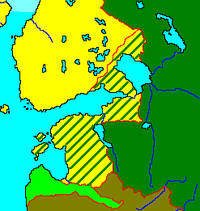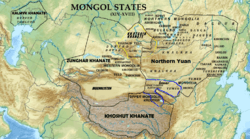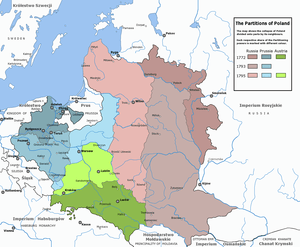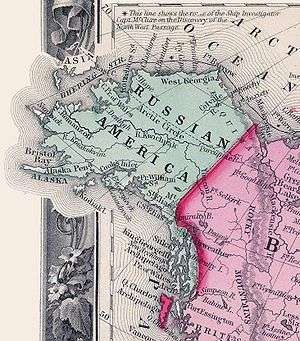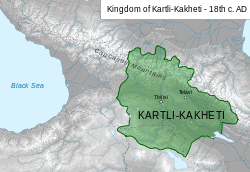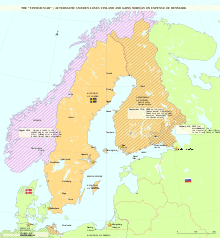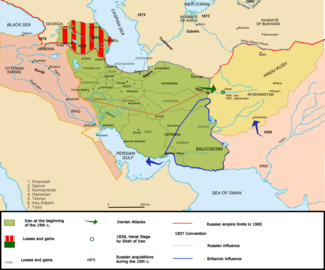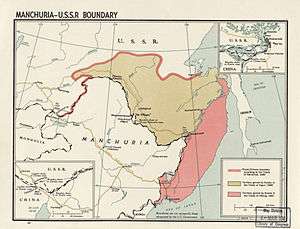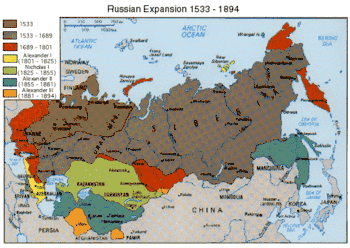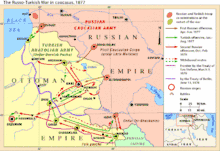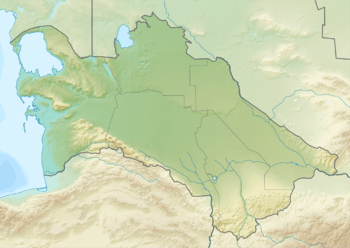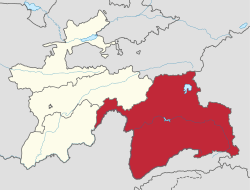Territorial evolution of Russia
Territorial changes of Russia happened by means of military conquest and by ideological and political unions in the course of over five centuries (1533–present).
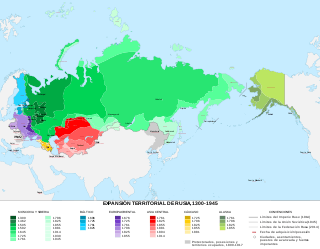
Russian Tsardom and Empire
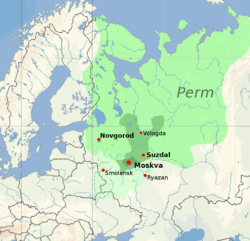
The name Russia for the Grand Duchy of Moscow started to appear in the late 15th century and had become common in 1547 when the Tsardom of Russia was created.
For the history of Rus' and Moscovy before 1547 : see Kievan Rus' and Grand Duchy of Moscow. Another important starting point was the official end in 1480 of the overlordship of the Tatar Golden Horde over Moscovy, after its defeat in the Great standing on the Ugra river.
Ivan III (reigned 1462–1505) and Vasili III (reigned 1505–1533) had already expanded Muscovy's (1283–1547) borders considerably by annexing the Novgorod Republic (1478), the Grand Duchy of Tver in 1485, the Pskov Republic in 1510, the Appanage of Volokolamsk in 1513, and the principalities of Ryazan in 1521 and Novgorod-Seversky in 1522.[1]
After a period of political instability, 1598 to 1613 the Romanovs came to power (1613) and the expansion-colonization process of the Tsardom continued. While western Europe colonized the New World, the Tsardom of Russia expanded overland – principally to the east, north and south.
This continued for centuries; by the end of the 19th century, the Russian Empire reached from the Black Sea to the Pacific Ocean, and for some time included colonies in the Americas (1732–1867) and a short-lived unofficial colony in Africa (1889) in present-day Djibouti.[2]
Expansion into Asia
The first stage from 1582 1650 so I North-East expansion from the Urals to the Pacific. Geographical expeditions mapped much of Siberia. The second stage from 1785 to 1830 looked South to the areas between the Black Sea and the Caspian Sea. The key areas were Armenia and Georgia, with some better penetration of the Ottoman Empire, and Persia. By 1829, Russia controlled all of the Caucasus as shown in the Treaty of Adrianople of 1829. The third era, 1850 to 1860, was a brief interlude jumping to the East Coast, annexing the region from the Amur River to Manchuria. The fourth era, 1865 to 1885 Incorporated Turkestan, and the northern approaches to India, sparking British fears of a threat to India in The Great Game.[3][4]
Table of changes
Soviet Union
After the October Revolution of November 1917, Poland and Finland became independent from Russia and remained so thereafter. Russia proper became the Russian SFSR (1917–1991) and eventually the Russian Federation (1991–present). Its area of effective direct control varied greatly during the Russian Civil War of 1917–1922. Eventually most of the former Eurasian lands of the Russian Empire were consolidated into one or more of each of the constituent republics of the Soviet Union (1922–1991).
After World War II the Soviet Union annexed:
- Karelia from Finland
- East Prussia (now Kaliningrad Oblast) from Germany
- the Kuril Islands and southern Sakhalin from Japan
- Tuva (independent 1921–1944; previously governed by Mongolia and by the Manchu Empire)
- West Belarus and West Ukraine from the Second Polish Republic
Territories of the former Russian Empire that permanently or temporarily became independent:
- Crimean People's Republic, 1917–1918
- Republic of Aras, 1918–1919
- Alash Autonomy, 1917–1920
- Kingdom of Lithuania (1918), 1918
- Ukrainian People's Republic, Ukrainian State, 1917–1921
- Duchy of Courland and Semigallia (1918), 1918
- First Republic of Armenia, 1918–1920
- Azerbaijan Democratic Republic, 1918–1920
- Kingdom of Finland (1918), 1918–1919
- Balagad state, 1919–1926
- North Caucasian Emirate, 1919–1920
- Republic of Latvia (1919–1940), 1919–1940
- Republic of Central Lithuania, 1920–1922
- Centrocaspian Dictatorship, 1918
- Democratic Republic of Georgia, 1918–1921
- Idel-Ural State, 1917–1918
- Moldavian Democratic Republic, 1917–1918
- Mountainous Republic of the Northern Caucasus, 1917–1920
- North Ingria, 1919–1920
- Republic of Oirat-Kalmyk, 1920
- Transcaucasian Democratic Federative Republic, 1918
Russian Federation
The dissolution of the Soviet Union has led to the creation of independent post-Soviet states, with the Russian SFSR becoming the Russian Federation. Territorial disputes of the Russian Federation involve both post-Soviet states and other neighbors.
The Chechen Republic of Ichkeria was an unrecognized secessionist government of the Chechen Republic during 1991–2000, which fought two wars against Russia until the government was exiled in 2000.
In 2014, Crimea was annexed by the Russian Federation. The annexation was not recognized by Ukraine, the United States, Canada, the European Union, and several other members of the international community.
See also
- Geography of Russia
- History of Russia
- history of Ukraine
- History of the administrative division of Russia
- Chechen–Russian conflict
- Foreign policy of the Russian Empire
- Russification
- Internal colonialism
- Near abroad
- Moscow, third Rome
- Foundations of Geopolitics
- Transnistria War
- Post-Soviet conflicts
- Karelian question
- Soviet Empire
References
- Allen F. Chew, An Atlas of Russian History: Eleven Centuries of Changing Borders (2nd ed. 1967). pp 14–43.
- John Channon, The Penguin historical atlas of Russia (1995) pp 8–12, 44–75.
- Brian Catchpole, A map history of Russia (1983) pp 6–31.
- Allen F. Chew, An Atlas of Russian History: Eleven Centuries of Changing Borders (2nd ed. 1967)
Further reading
- Bassin, Mark. "Russia between Europe and Asia: the ideological construction of geographical space." Slavic review 50.1 (1991): 1–17. Online
- Bassin, Mark. "Expansion and colonialism on the eastern frontier: views of Siberia and the Far East in pre-Petrine Russia." Journal of Historical Geography 14.1 (1988): 3–21.
- Forsyth, James. "A History of the Peoples of Siberia: Russia's North Asian Colony 1581–1990" (1994)
- Foust, Clifford M. "Russian expansion to the east through the eighteenth century." Journal of Economic History 21.4 (1961): 469–482. Online
- LeDonne, John P. The Russian empire and the world, 1700–1917: The geopolitics of expansion and containment (Oxford University Press, 1997).
- McNeill, William H. Europe's Steppe Frontier: 1500–1800 (Chicago, 1975).
- Subtelny, Orest (1988). Ukraine: A History. Toronto: University of Toronto Press. ISBN 978-0-8020-5808-9.
- Plamen Mitev, ed. Empires and peninsulas: Southeastern Europe between Karlowitz and the Peace of Adrianople, 1699-1829 (LIT Verlag Münster, 2010).
- Treadgold, Donald W. "Russian expansion in the light of Turner's study of the American frontier." Agricultural History 26.4 (1952): 147–152. Online
- Velychenko, Stephen, The Issue of Russian Colonialism in Ukrainian Thought.Dependency Identity and Development, AB IMPERIO 1 (2002) 323-66
Atlases
- Blinnikov, Mikhail S. A geography of Russia and its neighbors (Guilford Press, 2011)
- Catchpole, Brian. A map history of Russia (1983)
- Chew, Allen F. An Atlas of Russian History: Eleven Centuries of Changing Borders (2nd ed. 1967)
- Gilbert, Martin. Routledge Atlas of Russian History (4th ed. 2007) excerpt and text search
- Parker, William Henry. An historical geography of Russia (University of London Press, 1968)
- Shaw, Denis J.B. Russia in the modern world: A new geography (Blackwell, 1998)


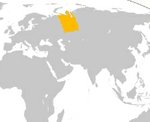
.svg.png)

